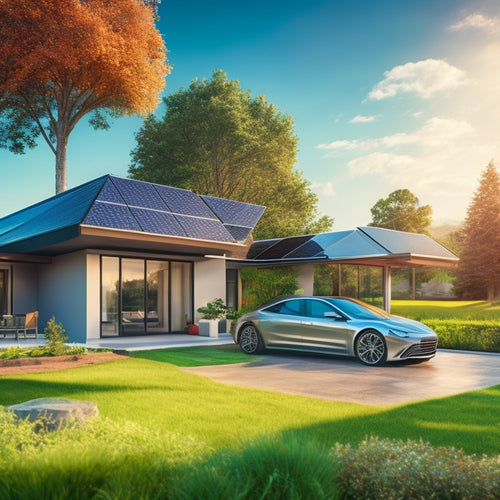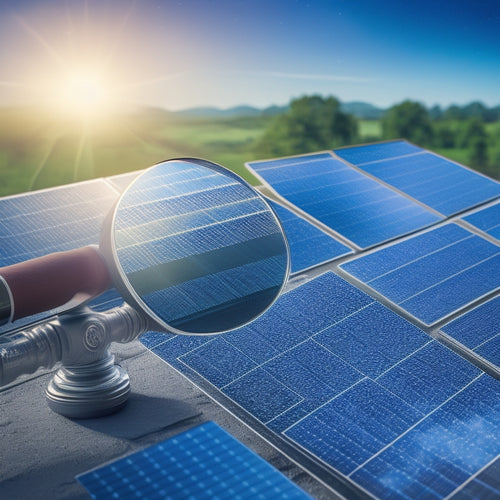
7 Essential Installation Tips for Tiny Home Solar Panels
Share
When designing and installing a solar panel system for your tiny home, you'll want to get it right the first time. Start by evaluating your energy needs, including daily consumption and appliance usage, to determine the required system size. Choose the right solar panel type based on efficiency, cost, and environmental impact. Confirm your roof can support the weight of the panels and plan for adequate space. Properly orient your panels to maximize energy production, considering factors like latitude and shading. Additionally, consider energy storage options, install a monitoring system, and follow local building codes to guarantee a safe and efficient system. By following these essential tips, you'll be well on your way to utilizing the power of solar energy for your tiny home.
Key Takeaways
- Assess daily energy usage to determine the required solar panel capacity for your tiny home, considering appliances, lighting, and electronics.
- Choose the right solar panel type (monocrystalline, polycrystalline, or thin film) based on efficiency, cost, environmental impact, and durability.
- Ensure proper panel orientation and tilt to maximize energy production, considering latitude and peak sun angle guidelines.
- Install a monitoring system to track real-time energy production and consumption, identifying areas for improvement and potential system issues.
- Collaborate with licensed professionals to ensure compliance with local building codes, safety standards, and regulations, and to access industry expertise.
Assess Your Energy Needs First
Your tiny home's energy requirements are the foundation of a successful solar panel installation. To determine your energy needs, you'll need to assess your energy consumption and lifestyle habits.
Start by tracking your daily energy usage, including appliances, lighting, and electronics. This will give you a clear illustration of your overall energy requirements. Consider your energy-intensive habits, such as cooking, refrigeration, and entertainment.
Also, think about your energy-efficient habits, like using LED bulbs or energy-efficient appliances.
Next, calculate your total daily energy consumption in watt-hours (Wh). You can use online tools or consult with a solar panel professional to help with the calculation. This will give you a clear understanding of the minimum amount of energy your solar panel system needs to produce.
Choose the Right Solar Panel Type
Selecting the right solar panel type is essential to ensuring your tiny home's energy needs are met efficiently. You'll want to evaluate three main types: monocrystalline, polycrystalline, and thin film technology.
Monocrystalline panels offer high solar panel efficiency, but come at a higher cost. Polycrystalline panels, on the other hand, provide a lower upfront cost, but slightly lower efficiency. Thin film technology is the most budget-friendly option, but its efficiency is considerably lower.
When choosing a solar panel type, reflect on the environmental impact, installation costs, and durability factors. Look for brands with a strong reputation and thorough warranty comparisons.
Maintenance requirements should also be a key aspect. While monocrystalline panels may require more maintenance, they're also more durable. Polycrystalline panels offer a good balance between cost and maintenance. Thin film technology requires the least maintenance, but its lower efficiency may not be suitable for your tiny home's energy needs.
Plan for Adequate Roof Space
Frequently, tiny home owners underestimate the importance of planning for adequate roof space when installing solar panels.
You'll need to verify your roof can support the weight of the panels, known as the roof load, as well as any additional equipment like inverters or mounting hardware. Consider consulting with a structural engineer or a licensed solar installer to determine your roof's load capacity.
Next, you'll need to conduct a shading analysis to identify any obstructions that could impact your solar panels' performance.
This includes trees, neighboring buildings, or even your own tiny home's vents or skylights. You can use online tools or hire a professional to perform a shading analysis, which will help you determine the best placement for your solar panels.
Ensure Proper Panel Orientation
Once you've determined the best roof space for your solar panel installation, it's time to focus on ensuring proper panel orientation. This is essential because it directly affects the amount of energy your solar panels can generate. The goal is to maximize energy production by aligning your panels with the sun's path.
To achieve peak energy production, consider the following factors:
| Latitude | Ideal Panel Tilt | Peak Sun Angle |
|---|---|---|
| 0° - 25° | 15° - 25° | 15° - 30° |
| 26° - 40° | 20° - 30° | 20° - 35° |
| 41° - 50° | 25° - 35° | 25° - 40° |
| 51° - 60° | 30° - 40° | 30° - 45° |
| 61° - 90° | 35° - 45° | 35° - 50° |
As you can see, the ideal panel tilt and sun angle vary depending on your latitude. By following these guidelines, you'll be able to enhance your solar panel orientation and maximize energy production. Remember, proper panel orientation is key to getting the most out of your tiny home solar panel installation.
Consider Energy Storage Options
When designing your tiny home's solar panel system, you'll need to evaluate energy storage options to guarantee a reliable power supply.
You'll want to determine the right battery bank configuration for your needs, factoring in elements like depth of discharge, cycle life, and charging efficiency.
A well-designed off-grid system will depend on a thoughtful integration of your solar array, charge controller, and energy storage components.
Battery Bank Considerations
As you design your tiny home's solar panel system, evaluating the battery bank's role in energy storage is crucial. A well-planned battery bank guarantees a reliable supply of power when the sun isn't shining or during periods of high energy demand.
When selecting a battery bank, you'll need to determine the required battery capacity based on your energy needs. This involves calculating your daily energy usage and choosing a battery bank that can store sufficient energy to meet those needs.
Maintenance requirements are another critical aspect to evaluate. Some battery types, like flooded lead-acid batteries, require regular maintenance, such as checking water levels and equalizing charges. In contrast, sealed batteries like AGM or lithium-ion batteries require minimal maintenance.
You'll need to weigh the trade-offs between maintenance needs and upfront costs to select the best battery bank for your tiny home. By carefully assessing these factors, you can create a reliable and efficient energy storage system that powers your tiny home with confidence.
Off-Grid System Design
Frequently, tiny homeowners overlook a crucial aspect of off-grid system design: carefully considering energy storage options.
You've carefully planned your solar panel placement to maximize energy generation, but what happens when the sun sets or during periods of low sunlight? A well-designed energy storage system guarantees you have a reliable source of power, even when the grid is unavailable.
When designing your off-grid system, consider the off-grid advantages you want to prioritize. Do you need to power critical loads like refrigeration, lighting, and communication devices? Or do you want to guarantee you have backup power for extended periods?
Your energy storage options will depend on your specific needs and goals. You'll need to determine the best battery bank size, type, and configuration to meet your energy demands.
Additionally, consider the depth of discharge, charge cycles, and maintenance requirements to guarantee your energy storage system operates efficiently and effectively over its lifespan.
Install a Monitoring System
You'll want to install a monitoring system that includes components such as inverters, sensors, and a user interface to track your tiny home's energy production and consumption.
This system will provide you with real-time data on your energy usage, allowing you to identify areas for improvement and optimize your solar panel performance.
System Components Overview
Design your monitoring system to keep tabs on your tiny home's solar panel performance, guaranteeing you maximize energy production and identify potential issues promptly. This system consists of several key components that work together to provide real-time data on your solar panel's operation.
First, you'll need a monitoring device that connects to your solar panel array. This device tracks the performance of your solar panels, including the voltage, current, and power output. Depending on your solar panel types, you may need specific monitoring devices that cater to your system's unique requirements.
For instance, if you have a grid-tie system, you'll need a monitoring device that can track your energy production and grid connection.
Your monitoring system will also require installation tools, such as wiring, connectors, and mounting hardware. Confirm you choose high-quality tools that are compatible with your monitoring device and solar panel system.
A well-designed monitoring system will provide you with the knowledge you need to optimize your solar panel performance, troubleshoot issues, and enjoy a reliable source of renewable energy for your tiny home.
Real-time Energy Tracking
As you investigate real-time energy tracking, installing a monitoring system becomes essential to optimize your tiny home's solar panel performance. This system allows you to track your energy consumption and production in real-time, ensuring you're getting the most out of your solar panels.
With real-time monitoring, you can identify areas of inefficiency and make adjustments to maximize your energy output. You'll also be able to detect any issues with your system, such as faulty panels or inverters, and address them promptly.
Here's a breakdown of what you can expect from a monitoring system:
| Feature | Benefit |
|---|---|
| Real-time energy monitoring | Track your energy consumption and production in real-time |
| Historical data analysis | Identify patterns and trends in your energy usage |
| Alert system | Receive notifications of system issues or inefficiencies |
| Remote access | Monitor your system from anywhere, at any time |
Follow Local Building Codes
Three essential aspects of tiny home solar panel installation - safety, efficiency, and compliance - hinge on following local building codes. You must guarantee that your solar panel system meets the necessary safety standards and regulations in your area.
Failure to do so can result in serious consequences, including electrical shock, fires, and even fines.
As you begin the permitting process, familiarize yourself with local building codes and ordinances. Research the specific requirements for tiny home solar panel installations in your jurisdiction, including electrical and structural standards.
You may need to obtain permits from local authorities before starting the installation process.
It's vital to work with a licensed and experienced solar panel installer who's well-versed in local building codes. They can guide you through the permitting process, making certain that your solar panel system meets all necessary safety standards and regulations.
Frequently Asked Questions
Can I Install Solar Panels on a Metal Tiny Home Roof?
When installing solar panels on your metal tiny home roof, you'll need to take into account the unique metal roof considerations, such as ensuring a watertight seal and using specialized installation techniques to secure the panels to the metal surface.
How Often Should I Clean My Tiny Home Solar Panels?
You'll want to clean your tiny home solar panels every 6-12 months, depending on environmental factors, to maintain peak energy production; create a maintenance schedule to guarantee regular cleaning frequency and maximize your investment.
Are Tiny Home Solar Panels Compatible With Propane Appliances?
As you trade diesel generators for silent solar power, you're likely wondering if your tiny home's propane appliances will play nice with your new panels - rest assured, they're compatible, enhancing your propane efficiency and energy independence.
Do Solar Panels Affect Tiny Home Resale Value?
You're wise to wonder if solar panels impact your tiny home's resale value. Here's the good news: your solar investment can enhance resale benefits, appealing to eco-conscious buyers and increasing your tiny home's marketability.
Can I Add More Solar Panels to My System Later?
Imagine having the power to utilize more energy at your fingertips! You can indeed add more solar panels to your system later, as long as you guarantee solar panel compatibility and plan for seamless system expansion.
Conclusion
As you commence your tiny home solar panel installation, remember that a successful expedition is paved with careful planning and attention to detail. Don't be like Icarus, who flew too close to the sun without a safety net - guarantee your energy needs are met and your system is optimized for maximum efficiency. By following these essential installation tips, you'll be utilizing the power of the sun like a pro, and reaping the rewards of a sustainable lifestyle.
Related Posts
-

What Solar Panels Work Best With EVS Online?
When shopping for solar panels online to power your electric vehicle, look for high-efficiency models that can withst...
-

Solar Panel System Certification Costs: A 10-Point Breakdown
You're looking to understand the costs associated with solar panel system certification. Your total certification cos...
-

Eco-Friendly Car Battery Solutions Available Online
You can now shop online for eco-friendly car battery solutions that not only reduce your carbon footprint but also of...


